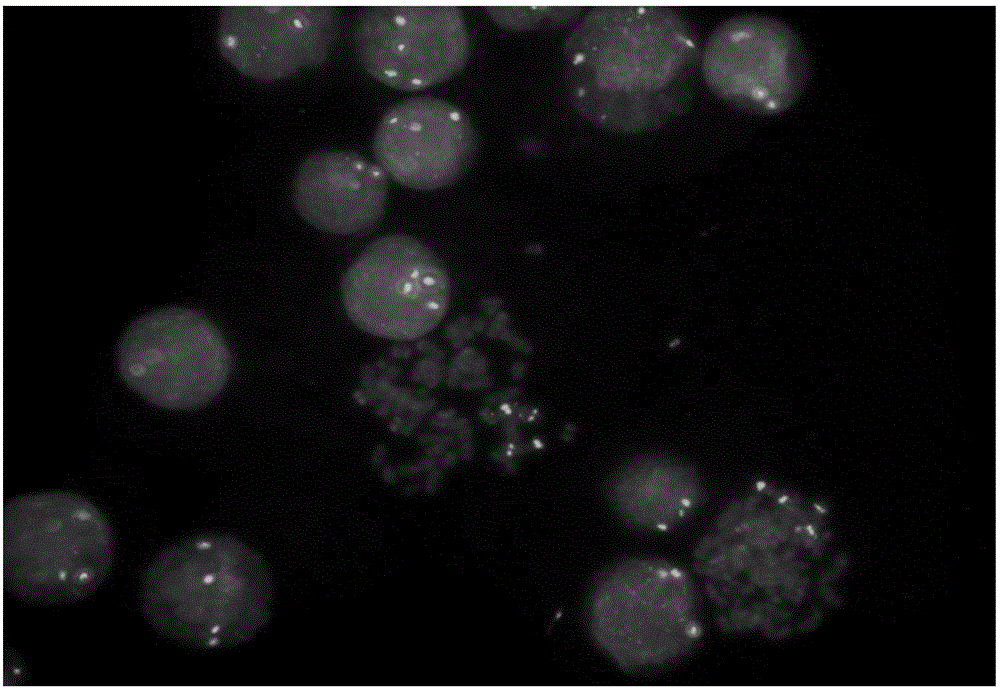Probe set for detecting breakage of TERT (Telomerase Reverse Transcriptase) gene, kit and application of probe set
A gene fragmentation and probe set technology, which is applied in recombinant DNA technology, microbial determination/inspection, DNA/RNA fragments, etc., can solve the problems of unsuitable for rapid detection of TERT genes in hospitals, complex sample processing, and long detection cycle. Achieve the effect of helping individualized treatment, high signal intensity, and high detection sensitivity
- Summary
- Abstract
- Description
- Claims
- Application Information
AI Technical Summary
Problems solved by technology
Method used
Image
Examples
Embodiment 1
[0044] Screening probe sets for detection of TERT gene disruption:
[0045] (1) Search for bacterial artificial chromosomes (BAC clones) corresponding to both sides of the TERT gene on chromosome 5 (ie, the telomere side and the centromere side) through http: / / genome.ucsc.edu / . The results showed that there are dozens of BAC clones covering the 500 KB at both ends of the TERT gene (chr5:1,253,287-1,295,162), but these clones have not been verified and lack specific descriptions.
[0046] (2) Probe design principle: Select multiple BAC clones of similar size on both sides of the gene breakpoint, control the farthest distance between the BAC clone fragments on both sides within 1500Kb and do not overlap each other, and multiple fragments on the same side interact with each other. There is a certain sequence overlap between them to avoid signal dispersion caused by large gaps. According to the above probe design principles, it is planned to select three BAC clones on one side of...
Embodiment 2
[0055] Preparation of fluorescently labeled BAC clone probe set for detection of TERT gene disruption:
[0056] The corresponding BAC clones were purchased from Invitrogen, and the plasmids were extracted after the BAC clones were cultured. Using the gap translation method, the two BAC clone fragments RP11-1107M2 and RP11-260H6 on the telomere side were labeled with green fluorescence with Sptectrum green-dUTP. Two BAC clone fragments RP11-325I22 and RP11-768M3 on the centromere side were labeled with red fluorescence by Sptectrumorange-dUTP. Prepare the labeled probe, Human cot-1 DNA, hybridization buffer, and purified water in proportion to make a probe hybridization solution, and store it in a dark freezer at -20°C.
Embodiment 3
[0058] Prepare a kit for detecting TERT gene disruption:
[0059] The probe hybridization solution prepared in Example 1 and the DAPI dye used for nuclear DNA staining constitute a kit.
PUM
 Login to View More
Login to View More Abstract
Description
Claims
Application Information
 Login to View More
Login to View More - R&D
- Intellectual Property
- Life Sciences
- Materials
- Tech Scout
- Unparalleled Data Quality
- Higher Quality Content
- 60% Fewer Hallucinations
Browse by: Latest US Patents, China's latest patents, Technical Efficacy Thesaurus, Application Domain, Technology Topic, Popular Technical Reports.
© 2025 PatSnap. All rights reserved.Legal|Privacy policy|Modern Slavery Act Transparency Statement|Sitemap|About US| Contact US: help@patsnap.com



